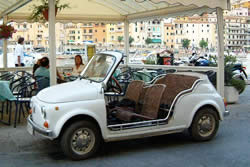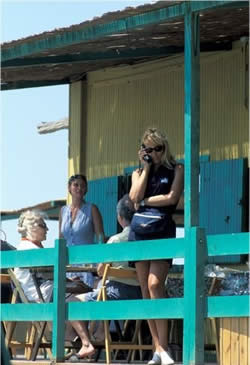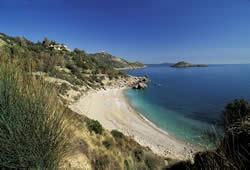- Home
- Destinations

Cala Grande, Argentario (Zoom in)
It’s an easy drive out of Rome onto the “Aurelia”, the road that heads up the coast following the route of the old Roman road. Very quickly you are out of an urban environment and bowling through productive-looking vegetable growing areas, bordered by roadside verges vibrant with the colour of wildflowers. Turning off the main route after about an hour and a half’s drive, you reach the promontory of Monte Argentario . On the map it looks almost like an island, linked to the mainland by three tendrils. In fact it was an ancient island which became joined to the coastline by two strips of accumulated sand enclosing a stretch of the Tyrrhenian Sea that is now the Orbetello lagoon, an area of intense ecological diversity administered by the World Wildlife Fund. The central strip of the three is partly man-made and connects Argentario to the town of Orbetello, itself on a narrow promontory and now surrounded on three sides by its lagoon.
In the sixteenth century the Spanish gained control of the area from the Republic of Siena and made Orbetello the capital of their “Stato dei Presidi”(the name for their sphere of influence in this part of Italy). One enters the town from the Aurelia through an impressive Hispanic-baroque gateway, built by the Spanish as part of a massive burst of fortification as they strove to consolidate their trading position in the Mediterranean.
On Monte Argentario itself and on up the coast there are constant reminders of more belligerent times, particularly the series of “Castelle” or look-out towers that stud the coastline. At Porto Ercole, one of the two main towns on Argentario, the fortresses of La Rocca, Filippo, Santa Carolina and Stella dominate the hillsides above the perfect little natural harbour. Now that Porto Ercole is a place more associated with pleasure, good food, boats and relaxation the profusion of these fortifications rather takes one by surprise but adds another interesting angle to this incredibly picturesque little port.

The other town on Argentario is Santo Stefano, a lively bustling port where you can catch the ferry to the neighbouring islands of Giglio and Giannutri.
Although there has been a fishing village here for centuries much of the town was bombed during the war and so had to be reconstructed. Cleverly they used a lot of the old stone for rebuilding which makes its newness far less obvious.
Along the front there is an excellent fish market and a profusion of restaurants, as well as the marina, where you can admire the beautiful yachts and luxurious gin-palaces. It is the perfect place for a “passegiata” the Italian word for taking a stroll while watching the world go by.
 Argentario is a remarkably unspoilt coastal haven, particularly considering its proximity to Rome. Since the 1970s there have been strict planning laws in place to preserve the natural beauty of the area. Consequently, if you drive round the west side of the promontory from one town to the other you find yourself on narrow roads wiggling along the coast surrounded by Mediterranean scrub; thyme, myrtle, rock roses, lavender, wild olive and fig. The land rises steeply above the road and falls away precipitously below it to the sea. It is an exhilarating and breathtaking journey, most spectacular at sunset when the whole sky seems to glow red, though not one to be undertaken in the dark by faint-hearted drivers.
Argentario is a remarkably unspoilt coastal haven, particularly considering its proximity to Rome. Since the 1970s there have been strict planning laws in place to preserve the natural beauty of the area. Consequently, if you drive round the west side of the promontory from one town to the other you find yourself on narrow roads wiggling along the coast surrounded by Mediterranean scrub; thyme, myrtle, rock roses, lavender, wild olive and fig. The land rises steeply above the road and falls away precipitously below it to the sea. It is an exhilarating and breathtaking journey, most spectacular at sunset when the whole sky seems to glow red, though not one to be undertaken in the dark by faint-hearted drivers. One of the best ways to enjoy Monte Argentario is to explore by boat the wealth of little coves around the coast which are inaccessible by road. There are numerous places in Porte Ecole or Santo Stefano that will hire you boats of all shapes and sizes. Alternatively you can take the ferry to the islands from Santo Stefano which gives you a fantastic view of the coastline of Argentario. The ferry’s first port of call is Giglio Porto, the pretty fishing village on the largest island of Giglio. It’s a beautiful place to wander round, with a castle at the top of the village to explore and lots of good restaurants. In the nearby cove Cala del Saraceno stand the ruins of a Roman villa. Giannutri, the smaller of the two islands, has no cars and so is a place to walk and take a picnic. It is well-known for its caves , particularly the Cala Dei Grottoni at the southern tip of the island and for the fine ruins of the Roman Domizi Enorbarbi villa with remains of mosaics, paved paths and columns.
 From Monte Argentario you have access to such a wide range of activities beaches and boats, walking and wildlife, culture and wonderful regional cooking.
From Monte Argentario you have access to such a wide range of activities beaches and boats, walking and wildlife, culture and wonderful regional cooking. Find out more about:
- Beaches
- Places of interest
- Things to do
- Local folk festivities
- Roads
- Weather
- Map of Monte Argentario
Argentario Quotes
“At the onset of their tempestuous affair in 1962, Richard Burton and Liz Taylor escaped from the set of Cleopatra in Rome, dodged the paparazzi (as well as their respective spouses) and headed up the coast to Monte Argentario. They considered that this unspoilt seaside enclave on the Tuscan coast was the ideal place for a tryst. And they were right.”
(Matthew Sturgis, Daily Mail, 5 June 2004)"I have never entirely understood the English love affair with Tuscany. To be buried among a breezeless series of parched hills and valleys at temperatures that render infants either dazed or hysterical has never seemed to me an attractive prospect. There is one exception to this prejudice, however, and that is Monte Argentario, a mountainous peninsula linked by a causeway to the Italian mainland, about one and a half hour's drive north-west of Rome".
(Dominic Lawson, Daily Telegraph, 1 June 2004)
Isola Rossa Ltd 257 Dover House Road London SW15 5BZ info@isolarossa.co.uk
Copyright Isola Rossa Ltd
